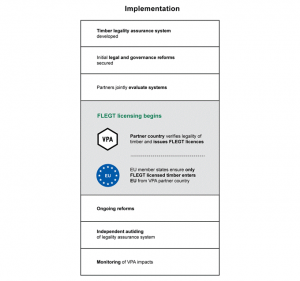To develop a Voluntary Partnership Agreement (VPA), the timber-exporting country and the EU go through four negotiation phases. These negotiation phases on the one hand include bilateral negotiations between the EU and the timber-exporting country and on the other, national negotiations within and between different stakeholder groups in the timber-exporting country. While bilateral negotiations formalise a VPA, the national discussions shape the agreement’s content.
Unlike in most trade agreements, in negotiating a VPA, the EU and a timber-exporting country are not adversaries. Instead, the parties work together to achieve a shared goal – to eliminate illegal logging. The EU supports the timber exporting country with technical assistance and capacity building. At the end of the four negotiation phases, a legally binding trade agreement in the form of a VPA is ratified by the EU and Laos. Additionally, for a VPA to be credible in the marketplace, it must provide EU importers with a guarantee that FLEGT licences are only issued to legal timber. The EU expects VPA processes to build and sustain national ownership of a credible VPA through broad stakeholder participation and by addressing problems identified by national stakeholders.
The stakeholder discussions in a timber-exporting country depend on the national context and the issues that concern stakeholders such as the private sector or the local government sector. There is no generic blueprint for a VPA process, the process varies between different countries. The flexibility of the VPA model allows stakeholders to develop an agreement that meets their specific needs and an appropriate roadmap for implementing the agreement.
The VPA process is unique in that it addresses the entire value chain from wood harvesting to the point of export. This enables the national government, the private sector and civil society representatives to reach consensus on how to promote legal forestry activities that support economic, social and environmental goals.
Implementation process
Experiences to date have shown that some governance challenges take time to address. It also takes time to ensure that the negotiating phase is credible and likely to yield results. In the implementation phase, which stakeholders enhance and/or develop the systems, institutions, capacity, legislative frameworks and governance reforms agreed in a VPA, is comprehensive and responds to new challenges as they emerge.
As VPA implementation is country-led and not driven by external funding, it requires strong national commitment. It can be a challenge to maintain momentum in VPA processes. The EU is therefore exploring ways to encourage a robust yet relatively rapid process for countries that are new to VPAs.
While FLEGT licensing is an important goal of a VPA process, it is not the end point. Governance reforms, impact monitoring, improvements to the timber legality assurance system and other measures continue.
Figure 1: The implementation phases of a VPA process

